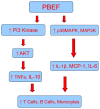Pre-B cell colony enhancing factor (PBEF), a cytokine with multiple physiological functions
- PMID: 23787158
- PMCID: PMC3791181
- DOI: 10.1016/j.cytogfr.2013.05.006
Pre-B cell colony enhancing factor (PBEF), a cytokine with multiple physiological functions
Abstract
Pre-B cell colony enhancing factor (PBEF) is regarded as a proinflammatory cytokine. Named for its first discovered function as a pre-B cell colony enhancing factor, it has since been found to have many other functions relating to cell metabolism, inflammation, and immune modulation. It has also been found to have intracellular and extracellular forms, with the two overlapping in function. Most of the intracellular functions of PBEF are due to its role as a nicotinamide phosphoribosyltransferase (Nampt). It has been found in human endothelial cells, where it is able to induce angiogenesis through upregulation of VEGF and VEGFR and secretion of MCP-1. In human umbilical endothelial cells, PBEF increases levels of the protease MMP 2/9. PBEF has also been found in a variety of immune cells other than B cells and has been shown to inhibit apoptosis of macrophages. Extracellular PBEF has been shown to increase inflammatory cytokines, such as TNF-α, IL-1β, IL-16, and TGF-β1, and the chemokine receptor CCR3. PBEF also increases the production of IL-6, TNF-α, and IL-1β in CD14(+) monocyctes, macrophages, and dendritic cells, enhances the effectiveness of T cells, and is vital to the development of both B and T lymphocytes. The purpose of this review is to summarize the recent advances in PBEF research.
Keywords: B lymphocyte; Chemokine; Monocyte; Pre-B cell enhancing factor; T lymphocyte.
Copyright © 2013 Elsevier Ltd. All rights reserved.
Conflict of interest statement
Figures



Similar articles
-
Critical role of PBEF expression in pulmonary cell inflammation and permeability.Cell Biol Int. 2009 Jan;33(1):19-30. doi: 10.1016/j.cellbi.2008.10.015. Epub 2008 Nov 1. Cell Biol Int. 2009. PMID: 18996492 Free PMC article.
-
Pre-B cell colony-enhancing factor (PBEF)/visfatin: a novel mediator of innate immunity.J Leukoc Biol. 2008 Apr;83(4):804-16. doi: 10.1189/jlb.0807581. Epub 2008 Feb 5. J Leukoc Biol. 2008. PMID: 18252866 Review.
-
The relationship of visfatin/pre-B-cell colony-enhancing factor/nicotinamide phosphoribosyltransferase in adipose tissue with inflammation, insulin resistance, and plasma lipids.Metabolism. 2010 Jan;59(1):93-9. doi: 10.1016/j.metabol.2009.07.011. Epub 2009 Sep 17. Metabolism. 2010. PMID: 19765775
-
Regulation of inflammatory cytokine expression in pulmonary epithelial cells by pre-B-cell colony-enhancing factor via a nonenzymatic and AP-1-dependent mechanism.J Biol Chem. 2009 Oct 2;284(40):27344-51. doi: 10.1074/jbc.M109.002519. Epub 2009 Aug 4. J Biol Chem. 2009. PMID: 19654329 Free PMC article.
-
Visfatin/pre-B-cell colony-enhancing factor: a protein with various suggested functions.J Endocrinol Invest. 2007 Feb;30(2):138-44. doi: 10.1007/BF03347412. J Endocrinol Invest. 2007. PMID: 17392604 Review.
Cited by
-
Nicotinamide Adenine Dinucleotide (NAD) Metabolism as a Relevant Target in Cancer.Cells. 2022 Aug 24;11(17):2627. doi: 10.3390/cells11172627. Cells. 2022. PMID: 36078035 Free PMC article. Review.
-
A Complex Relationship between Visfatin and Resistin and microRNA: An In Vitro Study on Human Chondrocyte Cultures.Int J Mol Sci. 2018 Dec 6;19(12):3909. doi: 10.3390/ijms19123909. Int J Mol Sci. 2018. PMID: 30563239 Free PMC article.
-
Pre-B-cell colony enhancing factor (PBEF) increases endothelial permeability in hypoxia/re-oxygenation model.Int J Clin Exp Med. 2015 Jun 15;8(6):8842-7. eCollection 2015. Int J Clin Exp Med. 2015. PMID: 26309537 Free PMC article.
-
Enhanced NAMPT-Mediated NAD Salvage Pathway Contributes to Psoriasis Pathogenesis by Amplifying Epithelial Auto-Inflammatory Circuits.Int J Mol Sci. 2021 Jun 25;22(13):6860. doi: 10.3390/ijms22136860. Int J Mol Sci. 2021. PMID: 34202251 Free PMC article.
-
Strong association of the polymorphisms in PBEF1 and knee OA risk: a two-stage population-based study in China.Sci Rep. 2016 Jan 11;6:19094. doi: 10.1038/srep19094. Sci Rep. 2016. PMID: 26752339 Free PMC article.
References
-
- Rongvaux A, Shea RJ, Mulks MH, et al. Pre-B-cell colony-enhancing factor, whose expression is up-regulated in activated lymphocytes, is a nicotinamide phosphoribosyltransferase, a cytosolic enzyme involved in NAD biosynthesis. Eur J Immunol. 2002;32:3225–3234. - PubMed
-
- Revollo JR, Grimm AA, Imai S. The regulation of nicotinamide adenine dinucleotide biosynthesis by Nampt/PBEF/visfatin in mammals. Curr Opin Gastroenterol. 2007;23:164–170. - PubMed
-
- Moschen AR, Kaser A, Enrich B, et al. Visfatin, an adipocytokine with proinflammatory and immunomodulating properties. J Immunol. 2007;178:1748–1758. - PubMed
Publication types
MeSH terms
Substances
Grants and funding
LinkOut - more resources
Full Text Sources
Other Literature Sources
Research Materials
Miscellaneous

